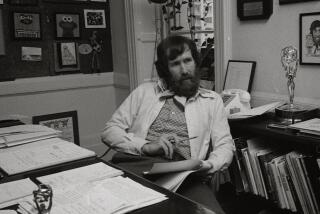The Muppets Will Carry On : Television: A treasury of old and new material will keep Jim Henson’s characters a part of ‘Sesame Street’ for years.
The recent death of puppeteer Jim Henson jolted “Sesame Street” fans of all ages. Would children notice a difference on the show that bears the unmistakable stamp of Henson’s genius? What was to happen to the Muppet creations that he himself gave voice to--his froggy green alter-ego, Kermit, mischievous Ernie and toothy game-show host Guy Smiley?
Anxiety was further heightened by national news reports that Ernie had been singled out for retirement. Ernie and his long-suffering, good buddy Bert (operated by veteran Muppeteer great, Frank Oz) are staunch friends, a favorite, beloved duo. To fans, separating them is unthinkable.
Since then, the Children’s Television Workshop in New York, which produces “Sesame Street” for PBS, reports being flooded with daily calls from concerned viewers who don’t want Bert to go solo.
They can rest easy, according to CTW president David Britt.
“As far as the kids (in the audience) are concerned,” he declared in an interview, “the show will go on as it always has.”
Britt is somewhat pained by the Ernie retirement story. It was, he maintained, an “unfortunate” error. Although no decision has been made about taping new segments with Ernie, Kermit and Guy--with someone else providing the voices--a stockpile of Henson-created material assures the characters’ continued appearances.
“We are not going to retire Ernie or Bert,” Britt stressed. “We have 20 years of Bert and Ernie, and Ernie by himself, (on tape) in our library.”
“Sesame Street,” which goes into production in September for the start of its new season in November, will use a combination of old and new material, as it always has, Britt explained.
“If you look at the show a lot,” he said, “you will see there is quite a bit of repetition of material. We do that mostly for pedagogical reasons, as well as economy. Kids really do learn from repeating things, and they love to look at stuff over and over again.
“Each year, we have done Muppet bits with Bert and Ernie and whoever--and the ones that are the best we use frequently. Those that make particular points, we use from time to time. We have enough that we can rest the segments for two to three years and then bring them back.”
In 16 weeks of production each year, Britt said, CTW tapes about 75 new, self-contained Muppet segments that can be dropped into the show at will. Of these, Henson was personally involved in about 50 each year, according to CTW spokeswoman Elizabeth Martin. And unlike some of the other characters--Big Bird or Oscar the Grouch, for instance--Henson’s characters were rarely involved in the live-action scenes taped with humans on the “Sesame Street” set.
The “Sesame Street” Muppet segments are a collaboration between Jim Henson Productions and “Sesame Street” producers, writers and researchers; Children’s Television Workshop holds exclusive rights to all “Sesame Street” Muppets, except for Kermit.
“At some point, when the Henson organization wants to sit down and talk about it,” Britt said, “we will decide whether we want to revoice (his three) characters and make new segments.”
Britt pointed out that “there are 15 co-productions of ‘Sesame Street,’ in Hebrew, Spanish, German and so on. And in each of those co-productions, there are different voices for the Muppets. So technically you could find other voices that would work well with the characters.”
But, he added, “In a funny way, it’s kind of a trade-off. Stuff that Jim and Frank (Oz) did as Bert and Ernie is so good, unless you were miraculous in finding a voice, I would guess it would be a hard choice to retire the old stuff and use new.”
Britt said that the treasury of re-usable material that Henson left was not his only legacy to “Sesame Street.”
“We are the beneficiaries of the fact that Jim was not only a great talent as a performer, but he was also a genius as a creator,” he said. “He gave us so many characters--some new ones like Elmo and Meryl Sheep and Alice Snuffalupagus, who are becoming popular in their own right--and he trained and developed a whole set of puppeteers and people who know how to develop new characters.”
“What I think is important about the evolution of ‘Sesame Street,’ ” Britt mused, “is that from the very first season, the show has adapted continually to changes. In the first season, the style was very much in the ‘60s. We’ve adapted to television changes, to societal changes, to different talents and to changes in curriculum.
“One of the things that has made the show strong and last as long as it has is that it’s focused not on setting a particular formula and then grinding it out forever, but on meeting needs and challenges as they go on. It’s dedicated to change. But God knows,” he added somberly, “this is not one I was looking for.”
Britt said that Henson’s death will not be dealt with on the show--the way that the passing of the character Mr. Hooper was handled when actor Will Lee died--because Henson himself was not seen on the show and his Muppets will go on.
Henson is the second major loss for “Sesame Street,” now offering entertainment and education to its second generation of children. Last year, the man who was the “sound of ‘Sesame Street,’ ” composer Joe Raposo, died of cancer at the age of 53. PBS recently ran a tribute to Raposo, celebrating the wealth of music he made in his lifetime.
Britt said that a similar tribute to Henson “is very much on my mind,” but would have to be discussed with the Henson organization.
More to Read
The complete guide to home viewing
Get Screen Gab for everything about the TV shows and streaming movies everyone’s talking about.
You may occasionally receive promotional content from the Los Angeles Times.






